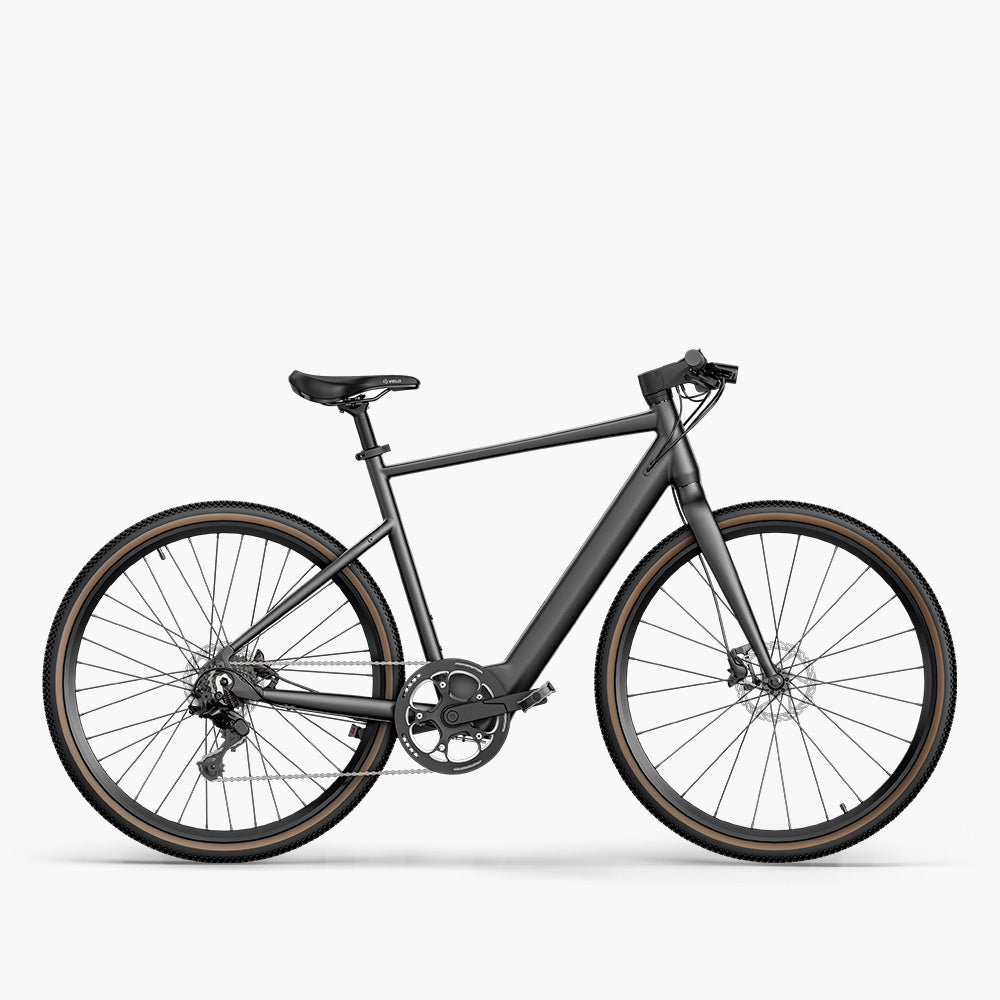Want to perform comprehensive maintenance on your electric bike? I hope this guide will help you.
From instantly responsive brakes to effortlessly gliding drivetrains, taking the time to fine-tune your ride now will give you miles of worry-free fun. Grab your tools and let's get your bike ready to go!

1.Brakes: Precision for Every Stop
Brakes are critical for safety, and ensuring they're in top shape is essential for any ride, especially after storage. Depending on your bike, you’ll have one of these three brake systems: mechanical disc brakes, hydraulic disc brakes, or rim brakes.
What to inspect:
- Brake Pads: Check for wear. Rim brake pads should be replaced if they’re less than 1/4 inch (6 mm) thick. For disc brakes, if the pad thickness is below 1.5 mm, it’s time for new ones.
- Brake Cables and Hoses: Inspect for fraying or cracking. Mechanical cables should move freely, while hydraulic lines should not have any fluid leaks.
- Rotors: Disc brake rotors should be smooth, with no warping. Measure the thickness—most should be replaced if they wear below 1.5 mm.
- Pro tip: Refer to your bike’s manual for torque settings and brake adjustments, especially for hydraulic systems. If you're unsure, many shops recommend brake maintenance at least once a year.
2.Drivetrain: Power in Every Pedal
Your bike's drivetrain—the chain, cassette, derailleur, and crankset—transfers your pedaling energy into forward motion. A well-maintained drivetrain boosts efficiency and prolongs the life of your bike.
Key maintenance tasks:
- Chain: Measure chain stretch using a chain checker tool. If the chain wear is over 0.5% for road bikes or 0.75% for mountain bikes, replace it to avoid damaging your cassette.
- Lubrication: Clean the chain with a degreaser and apply lubricant, ensuring you wipe away excess. Use a dry lube in dusty conditions and a wet lube in wet/muddy conditions.
- Cassette and Chainrings: Inspect for worn teeth. A new cassette or chainring usually has symmetrical teeth, while worn ones will look pointed or shark-like.
- Pro tip: Chains typically last between 2,000–3,000 miles, but this can vary depending on riding conditions. For smoother shifting, clean your drivetrain every 100-200 miles in dry conditions and after every ride in wet conditions.
3.Tires & Tubes: Your First Line of Comfort and Safety
Tire pressure and condition directly impact ride quality, speed, and safety. Low tire pressure can lead to flats and rim damage, while overly high pressure reduces traction.

What to check:
- Tire Pressure: Inflate to the recommended pressure (PSI) marked on the tire’s sidewall. Typically, road bike tires are 80-130 PSI, while mountain bike tires range from 30-50 PSI. For e-bikes, check the manual for specific PSI guidance, as it may vary.
- Tread Wear: Inspect for balding or cracks in the sidewall. Tires with less than 1.5 mm of tread or visible casing through the rubber should be replaced.
- Tubes: Check for punctures or slow leaks by inflating the tube and listening for air escaping. Replace if necessary.
- Pro tip: Tires lose about 1-2 PSI per week, so check pressure regularly. For optimal performance, inspect tire wear every 500 miles and replace tires every 2,000–3,000 miles, depending on road conditions.
4.Battery: Power Check for E-Bikes
For e-bike riders, the battery is crucial for maintaining that effortless assist. Battery care is key to maximizing lifespan, and e-bike batteries typically last between 3-5 years with proper maintenance.
Key maintenance points:
- Battery Charge: Ensure the battery is fully charged before your first ride of the season. Lithium-ion batteries should be recharged after each ride and kept between 20-80% charged during storage.
- Storage Temperature: Store the battery in a cool, dry place between 32°F and 77°F (0°C to 25°C) to avoid damaging it. Extreme cold or heat can shorten battery life.
- Voltage and Health: If your e-bike display shows voltage, check it. A drop of more than 10-15% after full charge may indicate battery degradation.
- Pro tip: To extend battery life, charge it every 1-2 months during off-seasons. Most e-bike batteries have a range of 20-70 miles per charge depending on terrain, rider weight, and pedal assist level, so plan accordingly.
5.Cables, Bolts, and Lights: Fine-Tuning for Reliability
Small components like cables, bolts, and lights might seem insignificant, but they’re crucial for a safe and functional ride.
What to check:
- Cables: Look for fraying or stiffness in brake and gear cables. Replace any worn-out cables or housings. Lubricate all cables for smoother operation.
- Bolts: Use a torque wrench to ensure that key bolts—especially on the handlebars, seat post, and pedals—are tightened to the recommended specifications (refer to your bike manual for exact torque settings).
- Lights: Test all lights to ensure they’re working, and replace batteries or recharge lights before your first night ride.
- Pro tip: Replace gear and brake cables every 1-2 years, depending on use. Tighten bolts to recommended torque settings to avoid over-tightening, which can strip threads or damage components.
6.Suspension: Keep the Bounce Without the Bumps
If your bike has suspension (on the fork or rear shock), regular maintenance ensures smooth travel and shock absorption, making rides comfortable and safe, especially on rough terrain.
What to inspect:
- Fork and Shock Seals: Look for oil leakage, which is a sign that seals are worn out. Clean the stanchions (the shiny metal part of the fork) and seals with a microfiber cloth.
- Suspension Tune: Check the air pressure or damping settings to ensure they match your riding weight and style. Suspension performance diminishes if air pressure is too low.
- Servicing: Suspension forks and shocks should be serviced every 50-100 hours of riding or annually, whichever comes first.
- Pro tip: Most manufacturers recommend suspension service every 6-12 months, depending on riding conditions. A suspension overhaul includes replacing seals, oil, and inspecting for internal wear.
Maybe you are looking for ways to clean your electric bike, then read on.
Cleaning: Maintain a Polished, Problem-Free Ride
A clean bike is more than just aesthetically pleasing—it helps prevent mechanical problems. Dirt and grime can cause wear on components and hide issues like cracks or rust.
Steps for cleaning:
- Frame: Use a gentle soap and water solution to wipe down the frame. Avoid using high-pressure hoses near bearings or electrical components.
- Chain and Drivetrain: Use a specific bike degreaser and brush to clean the chain, cassette, and derailleurs. Wipe everything down thoroughly before re-lubricating.
- Brakes: Clean the rims (for rim brakes) or the rotors (for disc brakes) with isopropyl alcohol to remove grease or grime that could affect braking performance.
- Pro tip: Clean your bike after every few rides in dry conditions and immediately after any ride in wet or muddy conditions. For e-bikes, avoid spraying water directly on the battery or motor area.
Introducing the various parts of the Fiido C21 electric bicycle
Introduction to the key parts of Fiido C21 electric bicycle
Brake: TEKTRO Hydraulic Brake
Transmission system:
Rear Derailleur: L-TWOO RD-5009-M
Chain: KMC X9
Rear Cogs: L-TWOO 9S (11-32T)
Inner tube: Yes
Electric power mileage: 80KM
Electric power assist maximum speed: 15.5MPH (25km/h)
Fiido E-Gravel C21 Electric Bike
Urban communter electric bike with torque sensor, only 17.5kg.
Conclusion
You've completed maintenance, and it's time to unfold your bike and let it hit the road. Remember that you're partly responsible for making the road safer, and you should try to do so. Wear your helmet always, no matter how short the ride distance.
Obey traffic signals and use hand signals to alert other road users of your intentions. Above all, be wary of pedestrians and other cyclists, and you'll enjoy every pedal of your bike during spring.
If you are considering buying a new electric bike, then you might want to take a look at Fiido electric bikes. From daily commuting to off-road electric bikes, from electric balance bikes suitable for children to straddle electric bikes suitable for the elderly, there are many models for you to choose from.













